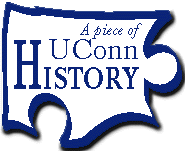This is an archived article. For the latest news, go to the Advance Homepage. For more archives, go to the Advance Archive/Search Page  | ||
|
With the campus master plan set for public presentation March 3, and with UConn 2000 well underway, attention has turned to the infrastructure of the Universit.
There were also campus construction booms in the 1920s and the 1950s and 1960s, and many of those buildings bear the names of prominent people in the University's histor. Gulley Hall has been the administration building since the 1960s, after Homer Babbidge (president from 1962-1972) moved into what is now the president's office on the second floor. But the building originally was, as you can read in stone on the north side, Horticulture Hall. It was built in 1908 at a cost of $55,000. In its basement was a room to demonstrate and operate spray apparatus for plant cultivation and rooms to store spray materials and prepare vegetables for market. There were also cold rooms to store fruits and vegetable. The first floor had a classroom that could accommodate 50 students, a laboratory and offices. The second floor had a lab for drawing and microscope work, a large room for the Museum of Natural History, and additional rooms for botanical work. There also once were greenhouses adjacent to the buildin. The building is named for Albert Gurdon Gulley (1848-1917), a professor of horticulture at Connecticut Agricultural College from 1894 until his death. A 1917 editorial in the Connecticut Campus said he was "one of the most beloved faculty members." He was the campus landscape gardener as well as a professor, and was responsible for most of the ornamental plantings in the early days of the colleg. It's still known as Hall Dorm, but it hasn't been a dormitory for nearly 40 years. Built in 1940, it was named for William Henry Hall (1867-1922), a state senator from West Willington who served nine terms in the state House and three terms in the state Senate. Several times, Hall was influential in getting funds appropriated by the General Assembly for Connecticut Agricultural College "to build much needed facilities such as a women's dormitory (Holcomb Hall) and other buildings," wrote Evan Hill in 198. During the 1911 legislative session, "the principal item requested was for a new dormitory for men. It seemed for a time as if the dormitory would be lost, but William Henry Hall stepped into the breach at the last minute and succeeded in getting it reinstated," wrote Walter Stemmons in his history of the college. That dorm became Koons Hal. Hall also served briefly as a trustee of the college. Appointed in 1920, he served until his death two years late. Some other buildings and who they are named fo.
Atwater Laboratory, built in 1930 and added to in 1958, is named for Wilbur Olin Atwater (1844-1907), director of the Storrs Agricultural Experiment Station from 1877 to 1902. He was influential in the creation of the first state agricultural station in the United States (in Middletown, where Atwater once taught at Wesleyan University) and in passage of the Hatch Act of 1877, which established an experiment station in each stat. Manchester Hall, built in 1940, is named for Harry Grant Manchester (1868-1957), an alumni trustee (1907-1942) and graduate of Storrs Agricultural School in 1891. He worked with four presidents while on the Board of Trustees and also served as chair. A year after graduation, he became president of the Alumni Associatio. Wood Hall, also built in 1940, was first a dormitory, then converted to offices for the College of Liberal Arts and Sciences in the 1960s. It is named for Walter Childs Wood (1864-1953), an M.D. and representative in the General Assembly from 1923 to 1931. He was also a trustee from 1922 to 1942. A dairy farmer, Wood also helped organize the Connecticut Farm Burea. Mark J. Roy Sources: Unpublished manuscript, Evan Hill, 1980. Connecticut Agricultural College: A History, Walter Stemmons, 193. |

